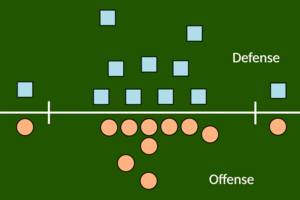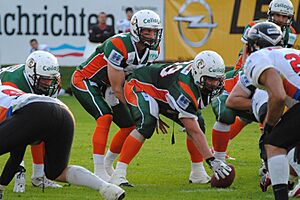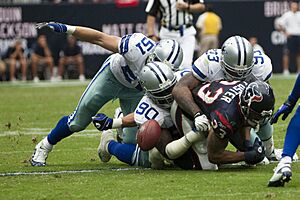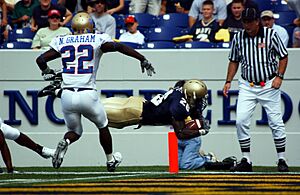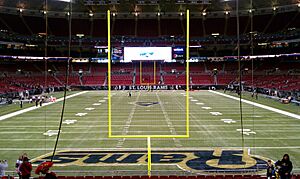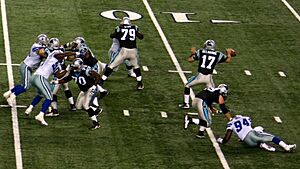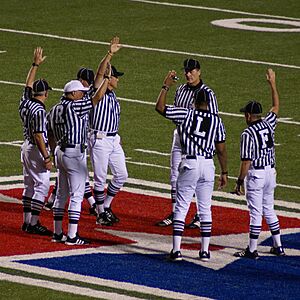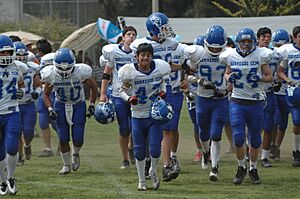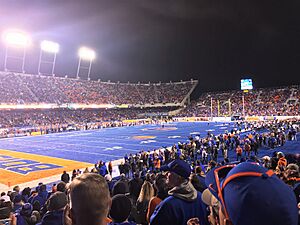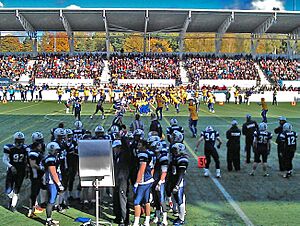American football facts for kids
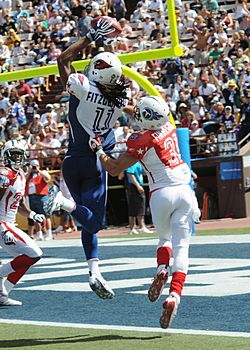
Larry Fitzgerald (in blue) catches a pass while Cortland Finnegan (in red) plays defense at the 2009 Pro Bowl.
|
|
| Highest governing body | International Federation of American Football |
|---|---|
| Nicknames |
|
| First played | November 6, 1869 New Brunswick, New Jersey, U.S. (Princeton vs. Rutgers) |
| Characteristics | |
| Contact | Full |
| Team members | 11 (both teams may freely substitute players between downs) |
| Type |
|
| Equipment |
|
| Venue | Football field (rectangular: 120 yards long, 53+1⁄3 yards wide) |
| Glossary | Glossary of American football |
| Presence | |
| Country or region | Worldwide (most popular in North America) |
| Olympic | Demonstrated at the 1904 and 1932 Summer Olympics, flag football at the 2028 Summer Olympics |
| World Games | Invitational sport at 2005, 2017, and 2022 (flag football) Games |
American football, often just called football in the United States and Canada, is a popular team sport. Two teams of eleven players play on a rectangular field with goalposts at each end. The team with the oval-shaped football is called the offense. Their goal is to move the ball down the field. They can do this by running with the ball or throwing it. The other team, the defense, tries to stop the offense and get the ball back.
The offense must move the ball at least ten yards in four tries, called downs. If they don't, the ball goes to the defense. If they succeed, they get a new set of four downs to keep going. Teams score points by getting the ball into the opponent's end zone for a touchdown. They can also kick the ball through the opponent's goalposts for a field goal. The team with the most points at the end of the game wins.
American football started in the United States. It grew from sports like soccer and rugby. The very first American football game was played on November 6, 1869. It was between two college teams, Rutgers and Princeton. The rules were mostly like soccer back then. Later, Walter Camp, known as the "Father of American Football," made many rule changes. These changes created the snap, the line of scrimmage, and the idea of downs. These rules made American football different from rugby.
Today, American football is super popular in the United States. Millions of people watch professional and college games. The National Football League (NFL) is the biggest professional league. Its championship game, the Super Bowl, is one of the most-watched sports events in the world.
Contents
What is American Football Called?
In the United States, people simply call American football "football." The name "football" became official in the rulebook in 1876. This was when the sport started to use more rugby-like rules. In other countries where other types of football (like soccer) are popular, people call it "gridiron" or "American football." This helps avoid confusion.
How American Football Started
Early Days of the Game
American football grew from rugby and soccer. Rugby is a sport where two teams try to get control of a ball. They can kick it through goalposts or run it into the opponent's goal area to score.
The first American football game was on November 6, 1869. It was between Rutgers and Princeton colleges. Each team had 25 players. They used a round ball that couldn't be carried. Players could kick or bat it with their feet, hands, or head to get it into the opponent's goal. Rutgers won 6–4.
Over the next few years, different colleges played with their own rules. In 1873, some colleges met to make a standard set of rules. However, Harvard liked a rugby-style game where players could run with the ball. Harvard played against McGill University using both American and Canadian (rugby) rules. Harvard players liked the Canadian style better. It had 11 players, allowed running with the ball, tackling, and used an oval-shaped ball.
In 1875, Princeton athletes saw a Harvard-Yale game played with rugby rules and were impressed. Princeton, Harvard, Yale, and Columbia then agreed to play using rugby rules with some changes. They formed the Intercollegiate Football Association.
Walter Camp, a Yale player, is known as the "Father of American Football." In 1880, he made important rule changes. He reduced each team from 15 to 11 players. He also brought in the snap, which replaced the messy scrum. The snap is when the center passes the ball between their legs to start a play.
How the Game Changed Over Time
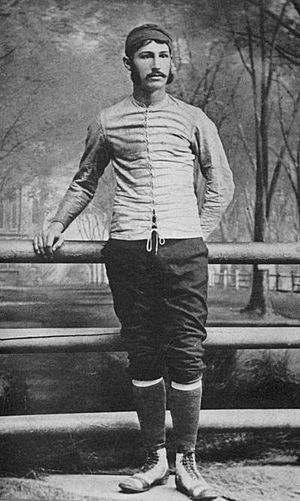
The snap led to a problem. Teams could just hold the ball forever to prevent the other team from scoring. In 1881, Yale and Princeton played a game where both teams did this, resulting in a 0–0 tie. Fans hated it!
To fix this, Walter Camp suggested a new rule in 1882. Each team would get three downs (or plays) to move the ball at least five yards. If they didn't, the other team would get the ball. This rule made American football very different from rugby. The field also got lines every five yards, making it look like a "gridiron" (a cooking grate).
Other big changes happened:
- The field size was set to 110 by 53 1/3 yards.
- Scoring was changed: 4 points for a touchdown, 2 for a safety, and 5 for a field goal.
- Tackling below the waist became legal.
- A line of scrimmage was created, where players line up before each snap.
Even with new rules, football was still very rough. Dangerous plays like the "flying wedge" caused many injuries and even deaths. In 1905, 19 players died. President Theodore Roosevelt said he would ban the game unless major changes were made. So, colleges met and formed the Intercollegiate Athletic Association of the United States. This later became the National Collegiate Athletic Association (NCAA).
In 1906, the forward pass became legal. This changed the game a lot! Other changes included:
- Game time reduced from 70 to 60 minutes.
- First down distance increased from 5 to 10 yards.
- The neutral zone was created between the teams before the snap.
- Field goals became worth 3 points in 1909.
- Touchdowns became worth 6 points in 1912.
- The field was shortened to 100 yards, with two 10-yard end zones.
- Teams got four downs instead of three to gain 10 yards.
The Professional Football Era
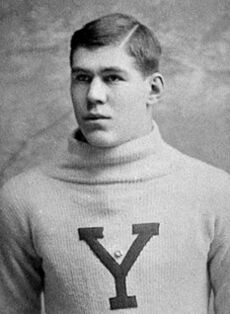
On November 12, 1892, Pudge Heffelfinger was paid $500 to play a game. This was the first time a player was officially paid to play American football. Before this, players might get indirect benefits, but direct payment was not allowed.
Over time, professional football became more common. In 1920, the National Football League (NFL) was formed. Its goals were to stop teams from fighting over players and to prevent college players from being paid while still in school. By 1922, the NFL was the top professional league in America.
Professional football really took off after the 1958 NFL Championship game. This game between the Baltimore Colts and the New York Giants was called the "Greatest Game Ever Played." Millions watched it on TV, and it made football much more popular. The new American Football League (AFL) also helped. It brought new ideas like keeping official time on a scoreboard and allowing two-point conversions after touchdowns.
The AFL and NFL were rivals for a while. But in 1966, they agreed to merge. This merger fully happened in 1970. They created a common draft for players and started an annual championship game. This game became known as the Super Bowl.
College football also has its own traditions. After the regular season, teams play in special "bowl games." Since 1992, different systems have been used to decide the national champion of college football. The current system is the College Football Playoff (CFP), which started in 2014.
Teams and Player Roles
A football game has two teams, each with 11 players on the field at a time. Teams can swap out players between plays. This means teams have special groups for offense, defense, and special teams. For example, the NFL has 53 players on its roster.
Players wear uniform numbers from 1 to 99. Some numbers might be "retired" by a team, meaning no one else can wear them.
Even though it's mostly played by men, girls and women can play football too. Women have played in high school and college games. In 2018, about 1,100 girls played in Pop Warner Little Scholars youth football.
The Offensive Team
The offense's job is to move the football down the field and score a touchdown.
Before each play, the offense must line up in a legal formation. Players cannot move until the ball is snapped, except for some players.
The main players on offense are:
- Quarterback (QB): The leader of the offense. They get the snap from the center and then hand off, throw, or run with the ball.
- Halfback/Tailback (HB/TB): Also called a running back. Their main job is to run with the ball. They can also catch passes.
- Fullback (FB): Usually bigger than halfbacks. They mainly block for other players but sometimes run the ball in short-yardage situations.
The offensive line (OL) protects the ball carrier and quarterback. They try to stop the defense from tackling the ball carrier or sacking the quarterback.
- Center (C): Snaps the ball to the quarterback and then blocks.
- Guards (G): Line up on either side of the center.
- Tackles (T): Line up outside the guards.
The main players who catch passes are:
- Wide receivers (WR): Line up near the sidelines. Their main job is to catch passes, but they also block.
- Tight ends (TE): Line up outside the tackles. They can catch passes and block.
The Defensive Team
The defense's job is to stop the offense from scoring. They do this by tackling the ball carrier. They also try to cause turnovers, which means getting the ball back. Turnovers happen when a defender catches a pass (an interception) or takes the ball from the ball-carrier (a forced fumble).
The defensive line (DL) tries to stop running plays and pressure the quarterback.
- Defensive ends (DE): Line up at the ends of the defensive line.
- Defensive tackles (DT): Line up inside, between the defensive ends.
Linebackers line up behind the defensive line. They are often the leaders of the defense. Their jobs include stopping runs, pressuring the quarterback, and covering receivers.
- Middle linebackers (MLB): Play in the middle.
- Outside linebackers (OLB): Play on the outside.
The defensive backfield, or secondary, covers receivers and stops deep passes.
- Cornerbacks (CB): Line up usually opposite a wide receiver to cover them.
- Safeties (S): Line up farther back in the secondary. They are often called the "last line of defense." They stop long passes and big running plays.
Special Teams Unit
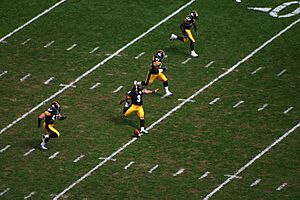
The special teams unit handles all kicking plays. When their team has the ball, they try to kick field goals, punts, or kickoffs. The other team's special teams try to block these kicks or return them.
Key players on special teams are:
- Placekicker (K or PK): Kicks field goals and extra points.
- Holder (H): Catches the snap and holds the ball for the placekicker.
- Long snapper (LS): Snaps the ball very accurately to the holder or punter.
- Punter (P): Kicks the ball far downfield to the other team.
- Kickoff returner (KR) and Punt returner (PR): Players who catch kickoffs or punts and try to run them back.
- Gunners: Players who run down the field quickly to tackle the punt returner.
Rules of the Game
How to Score Points
The team with the most points at the end of the game wins. Here's how teams score:
- Touchdown (TD): Worth six points. A touchdown happens when a player carries the ball into the opponent's end zone, catches a pass in the end zone, or recovers a loose ball there.
- Point(s)-After-Touchdown (PAT) or Conversion: After a touchdown, the scoring team gets one extra play.
- Extra Point: Worth one point. The team kicks the ball through the goalposts. This is usually successful.
- Two-Point Conversion: Worth two points. The team tries to get the ball into the end zone again, like a mini-touchdown. This is harder to do.
- Field Goal (FG): Worth three points. A player kicks the ball through the uprights and over the crossbar of the opponent's goalposts.
- Safety: Worth two points. A safety happens when the ball carrier is tackled in their own end zone. The defense gets these points. After a safety, the team that gave up the points must kick the ball to the scoring team.
The Field and Equipment
Football games are played on a rectangular field that is 120 yards long and 53 1/3 yards wide.
- The end lines are at each end of the field.
- The sidelines are along the sides.
- Goal lines are 10 yards in from each end line. The area between the goal line and the end line is the end zone.
- Yard lines are marked every 5 yards across the field.
- Hash marks are short lines that mark off 1-yard increments.
- Goalposts are at the center of each end line. They have a crossbar 10 feet off the ground and two uprights. To score a field goal or extra point, the ball must go between the uprights and over the crossbar.
The football is an oval-shaped leather ball. It's filled with air. It weighs between 14 and 15 ounces. Players wear special equipment to stay safe:
- Football helmets: Protect the head.
- Shoulder pads: Protect the shoulders and chest.
- Other pads: Thigh pads, knee pads, and sometimes elbow pads.
- Mouthguards: Protect teeth.
Game Length and Time Stoppages
Professional and college football games last 60 minutes. They are divided into two 30-minute halves and four 15-minute quarters. High school games are 48 minutes long, with 12-minute quarters. There's a halftime break between the two halves.
Before the game, the referee and team captains do a coin toss. The winning team decides whether to kick off, receive the ball, or choose which goal to defend first.
Games usually last longer than 60 minutes because the clock stops often. The game clock measures the total time. A separate play clock shows how much time the offense has to start the next play (usually 40 seconds). If they don't start the play in time, they get a penalty.
Moving the Ball and Downs
The offense can move the ball in two main ways: running or passing.
- A play starts with the snap, where the center passes the ball to the quarterback.
- The quarterback can then hand the ball to a running back, throw it, or run with it themselves.
- A play ends when the player with the ball is tackled, goes out of bounds, or an incomplete pass hits the ground.
- A forward pass can only be thrown from behind the line of scrimmage. Only one forward pass is allowed per down.
- Players can also pass the ball backwards (a lateral pass) at any time.
The offense gets a series of four plays, called downs.
- If they gain 10 or more yards in those four downs, they get a new set of four downs.
- If they fail to gain 10 yards, the ball goes to the other team.
- On fourth down, teams often punt the ball to the other team to make them start farther away. If they are close enough to the goalposts, they might try a field goal.
A group of officials called the chain crew keeps track of the downs and measures distances with a 10-yard chain. On TV, you often see a yellow line on the field that shows the first down line.
Kicking the Ball

There are two main types of kicks:
- Scrimmage kicks: These happen during a regular play from the line of scrimmage. They include place kicks (for field goals and extra points) and punts.
- Free kicks: These happen to start a half or after a score. They include kickoffs and safety kicks.
On a kickoff, the ball is kicked from a tee. On a safety kick, the ball is kicked from the 20-yard line. The kicking team can recover the ball after it has gone at least 10 yards and touched the ground or been touched by the receiving team.
The receiving team can signal for a fair catch on a punt. If they do, the play ends as soon as they catch the ball, and they cannot be tackled.
Officials and Penalties
Officials make sure the game rules are followed and manage the clock. They wear black-and-white striped shirts. If an official sees a rule broken (a foul), they throw a yellow flag.
There are usually seven officials on the field, each with different jobs:
- Referee: The head official. They oversee the game, announce penalties, and make final decisions on rules.
- Umpire: Watches the offensive and defensive linemen for fouls.
- Back Judge: Checks for legal catches and pass interference, and watches the play clock.
- Head Linesman/Down Judge: Watches the line of scrimmage, rules on out-of-bounds plays, and oversees the chain crew.
- Side Judge: Helps the head linesman and watches for fouls.
- Line Judge: Watches the line of scrimmage, manages player substitutions, and keeps track of game time.
- Field Judge: Watches the play clock, counts defensive players, and checks for offensive pass interference.
- Center Judge: (Used in college football) Helps spot the ball and has similar duties to the referee.
The chain crew uses two large sticks with a 10-yard chain between them to measure for first downs. They also use a down marker to show the current down. This system has been used for over 100 years and is very accurate.
Player Safety and Health
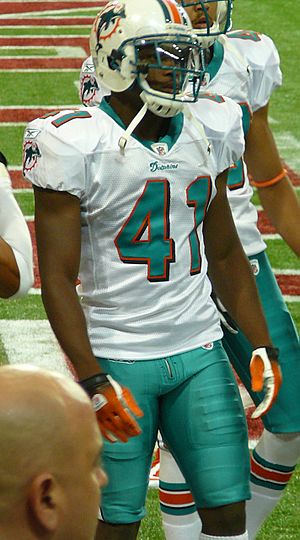
Football is a full-contact sport, so injuries can happen. Players must wear protective equipment to help prevent injuries. This includes helmets, shoulder pads, thigh pads, knee pads, and mouthguards.
One concern in football is concussions, which are head injuries. Repeated concussions can sometimes lead to long-term health problems. Many programs, like USA Football's "Heads Up Football," teach players and coaches safer ways to play and tackle to reduce head impacts.
A study in 2018 found that playing tackle football before age 12 might be linked to earlier symptoms of certain brain health issues later in life. This is why many youth leagues are focusing on safer playing techniques.
Leagues and Tournaments

The two most popular football leagues in the United States are the National Football League (NFL) and the National Collegiate Athletic Association (NCAA).
- National Football League (NFL): Started in 1920, it's the biggest and most popular sports league in the U.S. NFL games have the highest average attendance of any sports league in the world. The NFL championship game, the Super Bowl, is a huge event watched by millions globally.
- College Football: This is the third-most popular sport in the U.S. The NCAA organizes college football into different divisions. The top college teams compete for a national championship through the College Football Playoff (CFP).
- High School Football: This is the most popular sport for boys in U.S. high schools. Over a million boys play it. The National Federation of State High School Associations (NFHS) is the largest organization for high school football.
Other Professional Leagues
Over the years, other leagues have tried to compete with the NFL. The most successful was the American Football League (AFL), which merged with the NFL in 1970. Other leagues, like the World Football League (WFL) and the United States Football League (USFL), didn't last as long. Newer leagues like the XFL have also tried to start up.
International Play
American football is played in many countries around the world, but it's not as popular globally as sports like baseball or basketball. It's not an Olympic sport, but flag football, a modified version, might be played at the 2028 Summer Olympics.
- Canada: Canadian football is very popular and is closely related to American football.
- Mexico: American football has a long history in Mexico and is very popular in colleges. There's also a professional league called the Liga de Fútbol Americano Profesional (LFA).
- Japan: The sport was introduced in 1934. Japan has many high school and college teams, and a professional league called the X-League.
- Europe: Countries like Germany and the United Kingdom have their own football leagues. The NFL also hosts regular season games in London.
- Brazil: Football is growing fast in Brazil. Games are shown on TV, and many people play non-contact versions of the sport on beaches.
The International Federation of American Football (IFAF) is the global group that runs tournaments like the IFAF World Championship. They are working to make flag football an Olympic sport.
Popularity and Cultural Impact
In the United States
American football is the most popular sport in the United States. Polls show that professional football is the favorite sport for many Americans, with college football also being very popular. It's also the most played sport in high schools and colleges.
The Super Bowl is the biggest single-day sports event in the U.S. It's watched by over 100 million Americans every year. The NFL makes billions of dollars in revenue each year.
Football is a big part of American culture:
- Super Bowl Sunday is almost like a national holiday.
- Many college football bowl games are played on New Year's Day.
- Thanksgiving football is a tradition, with many games played on that day.
- The sport often teaches values like playing through pain and working together for the team.
In Other Countries
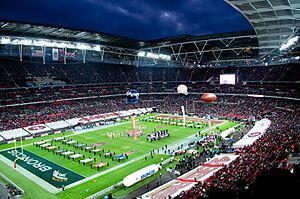
- Canada: The NFL is the third-most followed league in Canada, after the NHL and CFL.
- Mexico: The NFL says it has over 16 million fans in Mexico.
- Japan: Football has been played in Japan since 1934 and has many high school and college teams.
- United Kingdom: The NFL hosts games in London every year, and Super Bowl viewership has grown.
- Brazil: Football is one of the fastest-growing sports in Brazil, with many fans watching NFL games on TV.
- Other Countries: Interest in American football is growing in the Middle East and China, with new leagues forming and more people watching games.
Different Kinds of Football

- Canadian football: This is very similar to American football but has some key differences. The field is longer, teams have 12 players instead of 11, and they get three downs instead of four.
- Indoor football: This is played on a smaller field, usually indoors. Leagues can be less stable, but it's a fun, fast-paced version of the game. The Arena Football League was a well-known indoor league.
- Non-contact football:
- Flag football: Instead of tackling, defenders pull a flag from the ball-carrier's waist.
- Touch football: The ball-carrier is "downed" just by being touched, usually with one or two hands.
See Also
 In Spanish: Fútbol americano para niños
In Spanish: Fútbol americano para niños
- American football strategy
- Comparison of American football and rugby union
- Comparison of American football and rugby league
- Fantasy football (gridiron)
- List of American football films
- Lists of American football players
- List of American football stadiums by capacity
- List of American and Canadian football leagues
- List of female gridiron football players
- Doping in American football
- Women's gridiron football
Images for kids
-
Pudge Heffelfinger, widely regarded as the first professional football player.


